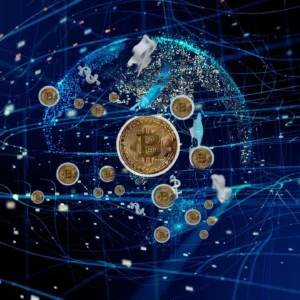
Outline:

Introduction
- Define DeFi (Decentralized Finance) and its growing impact on global banking infrastructure.
- Brief overview of how DeFi is disrupting traditional financial systems and banking models.
- Mention the challenges and opportunities of scaling DeFi in 2025, especially concerning regulatory frameworks.
2: What is Decentralized Finance (DeFi)?
- Definition and core concepts of DeFi.
- The difference between DeFi and traditional finance systems.
- Key features of DeFi: blockchain technology, smart contracts, and cryptocurrency.
3: Key Benefits of DeFi for the Global Financial System
- Transparency: How DeFi enhances transparency in financial transactions.
- Lower costs: How DeFi eliminates intermediaries and reduces transaction fees.
- Accessibility: Making financial services available to the unbanked population worldwide.
3: How DeFi is Redefining the Global Banking Infrastructure
- Introduction to the transformation of the banking infrastructure by DeFi.
- The shift from centralized banks to decentralized financial systems.
- How DeFi platforms provide a direct alternative to traditional banking services.
3: 1. Peer-to-Peer Lending and Borrowing
- How DeFi enables peer-to-peer lending and borrowing through smart contracts.
- Benefits over traditional bank loans, such as faster approvals and lower interest rates.
- Examples of leading DeFi lending platforms: Aave, Compound, and MakerDAO.
3: 2. Decentralized Exchanges (DEXs) and Asset Trading
- The rise of DEXs like Uniswap and SushiSwap.
- How DEXs provide a new model for cryptocurrency and traditional asset trading.
- Advantages of non-custodial exchanges over traditional centralized exchanges.
3: 3. Stablecoins and Their Role in DeFi
- What are stablecoins and how they provide stability in a volatile cryptocurrency market.
- The growing use of stablecoins like USDT, USDC, and DAI in DeFi applications.
- How stablecoins improve the accessibility of DeFi services for traditional users.
3: 4. Yield Farming and Staking in DeFi
- The concept of yield farming and how it generates passive income for DeFi participants.
- The role of staking in supporting DeFi networks and earning rewards.
- How users can access higher yields compared to traditional bank savings accounts.
Regulatory Challenges and the Future of DeFi
- Overview of the regulatory landscape surrounding DeFi.
- The need for government regulation and compliance for DeFi platforms.
- How global regulators are addressing DeFi compliance challenges in 2025.
3: 5. Lack of Legal Frameworks for DeFi
- Current challenges in creating a global regulatory framework for decentralized systems.
- The need for interoperable regulations to support cross-border DeFi transactions.
- Ongoing efforts by governments and organizations to address these challenges.
3: 6. Risk of Fraud and Scams in the DeFi Space
- The risks associated with unregulated DeFi platforms.
- How rug pulls, smart contract bugs, and security vulnerabilities pose threats to investors.
- Steps the DeFi community is taking to mitigate risks through better security measures.
3: 7. Anti-Money Laundering (AML) and Know-Your-Customer (KYC) Challenges
- The role of AML and KYC in ensuring the security and integrity of DeFi platforms.
- The challenge of implementing AML/KYC requirements in decentralized systems.
- How DeFi projects are working with regulators to find a balance between privacy and compliance.
Scalable Innovation and the Future of DeFi
- Introduction to the technological innovations making DeFi scalable in 2025.
- How advancements in blockchain technology and smart contracts are propelling DeFi forward.
- The potential for DeFi to become a mainstream financial system by 2025.
3: 8. Layer 2 Solutions and Their Impact on DeFi Scaling
- The importance of Layer 2 solutions like Optimism, Arbitrum, and Polygon in reducing gas fees and improving transaction speeds.
- How these solutions enhance the scalability of DeFi platforms.
- Real-world use cases of Layer 2 networks in the DeFi ecosystem.
3: 9. Interoperability Between Blockchains
- How interoperability between different blockchain networks allows seamless DeFi transactions.
- Key projects focusing on cross-chain compatibility, such as Polkadot and Cosmos.
- The future of multi-chain DeFi and the advantages of interoperable platforms.
3: 10. The Role of Artificial Intelligence (AI) in DeFi Innovation
- How AI and machine learning can optimize DeFi processes, such as price prediction, liquidity management, and risk analysis.
- Examples of AI-powered DeFi platforms enhancing the user experience and improving financial outcomes.
3: 11. The Growing Role of NFTs in DeFi
- How Non-Fungible Tokens (NFTs) are being integrated into DeFi platforms to create new financial instruments.
- The potential for NFTs to represent real-world assets within decentralized financial systems.
The Global Impact of DeFi in 2025
- DeFi’s potential to disrupt traditional finance on a global scale.
- How DeFi can address financial exclusion and provide access to financial services in underserved regions.
- Challenges and opportunities as the world transitions to a more decentralized financial system.
3: 12. Financial Inclusion: DeFi’s Impact on the Unbanked
- How DeFi offers solutions for the unbanked and underbanked populations, especially in developing countries.
- The role of blockchain technology in providing financial services without traditional intermediaries.
3: 13. DeFi and Traditional Financial Institutions
- The evolving relationship between DeFi platforms and traditional financial institutions.
- How banks and investment firms are adopting DeFi technologies for more efficient services.
- The potential for partnerships between traditional finance and DeFi platforms in 2025.
Conclusion
- Recap of the transformative power of DeFi in global banking infrastructure.
- Summary of DeFi’s benefits, challenges, and the road ahead for regulatory frameworks and scalable innovation.
- Final thoughts on DeFi’s potential to reshape the financial landscape and the role it will play in 2025 and beyond.
FAQs
1. What is the main difference between DeFi and traditional finance?
2. How can DeFi platforms ensure security and protect users from fraud?
3. How do Layer 2 solutions improve DeFi scalability and reduce transaction costs?
4. What are the key challenges DeFi faces in terms of regulatory compliance?
5. Can I use DeFi to earn passive income, and if so, how?
READ MORE: mastering-daily-budgeting-for-financial-success
Unlocking the Revolutionary Power of Decentralized Finance (DeFi): Redefining Global Banking Infrastructure, Overcoming Regulatory Challenges, and Driving Scalable Innovation in 2025
INTRODUCTION –
What is Decentralized Finance (DeFi)?
Decentralized Finance (DeFi) refers to a system of financial services built on blockchain technology that operates without intermediaries such as banks or financial institutions. DeFi allows individuals to participate in lending, borrowing, trading, and investing without relying on traditional financial intermediaries. It utilizes smart contracts—self-executing contracts with the terms of the agreement directly written into lines of code—to enable trustless financial transactions.
At its core, DeFi leverages the power of blockchain technology to create a decentralized financial ecosystem that is open, transparent, and accessible to anyone with an internet connection. This peer-to-peer approach to finance eliminates the need for banks and other middlemen, reducing transaction costs, increasing financial inclusion, and providing users with more control over their assets.
Why Do You Need an Emergency Fund?
The key benefits of DeFi are transparency, low-cost transactions, and global accessibility. It opens up financial services to people who are unbanked or underbanked, especially in regions where traditional banking infrastructure is weak or nonexistent. DeFi provides an opportunity for financial empowerment, allowing anyone to access the same financial tools that were once available only to those with access to traditional banking systems.
However, DeFi is still in its early stages and requires a robust regulatory framework to protect users from risks such as fraud, scams, and volatility. As the DeFi space grows, it will be crucial for governments, regulators, and the DeFi community to collaborate on creating a secure, transparent, and compliant environment that balances innovation with user protection.
How DeFi is Redefining the Global Banking Infrastructure
DeFi is fundamentally changing how we interact with money, bank accounts, and financial services. The traditional centralized banking system relies on institutions to provide services like savings accounts, loans, and asset trading. With DeFi, these services are replaced by blockchain networks and smart contracts that allow individuals to participate directly in the financial system.
- Peer-to-Peer Lending and Borrowing: DeFi allows users to lend their assets to others and earn interest, bypassing traditional banks and lenders.
- Decentralized Exchanges (DEXs): DEXs like Uniswap and SushiSwap allow users to trade cryptocurrencies directly without the need for centralized exchanges, offering lower fees and greater privacy.
- Stablecoins: DeFi utilizes stablecoins like DAI and USDT to reduce the volatility typically associated with cryptocurrencies, providing a more stable form of value exchange.
In essence, DeFi is building a parallel financial ecosystem that operates independently of traditional banks, providing faster, cheaper, and more inclusive financial services.
Regulatory Challenges and the Future of DeFi
Regulatory Challenges and the Future of DeFi
Decentralized Finance (DeFi) is revolutionizing the financial landscape by offering decentralized and borderless financial services. However, the regulatory framework surrounding DeFi remains one of its biggest challenges. As DeFi platforms continue to grow, the lack of established global regulatory standards creates uncertainties for developers, users, and investors.
In its current form, DeFi operates without intermediaries or centralized authorities, making it difficult for regulators to oversee transactions, enforce rules, or ensure compliance with traditional financial regulations. This decentralization, while a key advantage of DeFi, complicates regulatory oversight, leading to a range of challenges:
1. Absence of Clear Legal Frameworks
The most pressing regulatory challenge for DeFi is the lack of a unified legal framework. Financial regulations vary from country to country, and each jurisdiction has its own rules concerning cryptocurrency use, lending activities, taxation, and consumer protection. DeFi, which operates on a global scale, doesn’t adhere to the boundaries of individual countries. This makes it hard for regulatory bodies to apply traditional financial laws to DeFi platforms.
Governments are struggling to catch up with the rapid development of DeFi technologies, and regulatory authorities are facing difficulties in applying existing rules to decentralized systems. The future of DeFi relies on cooperation between global regulators and the DeFi community to establish clear rules that preserve the benefits of decentralization while protecting users and the broader financial system.
2. Risk of Fraud and Scams
The absence of central regulatory oversight leaves DeFi platforms vulnerable to fraud and scams. Since users don’t rely on traditional financial institutions to provide security and transaction validation, there are higher risks of malicious activities like rug pulls, smart contract vulnerabilities, and hack attacks.
- Rug pulls: In some DeFi projects, developers create tokens and attract investors, only to withdraw all the funds from the liquidity pool, leaving investors with worthless assets.
- Smart contract vulnerabilities: DeFi platforms operate through smart contracts, which are pieces of code that automatically execute transactions when conditions are met. If these contracts aren’t thoroughly audited, they are susceptible to coding flaws that can lead to significant financial losses.
- Hack attacks: With the rise of DeFi’s popularity, there has been an increase in cyber-attacks targeting platforms with weak security measures.
These security issues have raised concerns among regulators, as the decentralized nature of DeFi platforms complicates the ability to prosecute fraudulent actors or ensure user protection.
3. Anti-Money Laundering (AML) and Know Your Customer (KYC) Compliance
Anti-money laundering (AML) and Know Your Customer (KYC) regulations are designed to prevent illegal activities such as money laundering, terrorism financing, and identity theft. These regulations require financial institutions to collect information about their clients and report suspicious transactions to authorities.
However, implementing AML and KYC measures in DeFi is challenging. Since DeFi platforms are decentralized, users do not need to go through the typical KYC process to access services, making it difficult for regulators to trace and monitor financial activities. This creates a loophole that could be exploited for illicit activities.
The lack of KYC verification on DeFi platforms also exposes the crypto space to heightened illegal activities, leading to calls for more comprehensive regulatory frameworks that would ensure that AML and KYC compliance is integrated without compromising the privacy or decentralized nature of the technology.
4. Ensuring Consumer Protection
With traditional financial systems, consumer protection laws are in place to safeguard customers from fraud, poor service, and loss of funds. However, DeFi platforms do not have the same consumer protection mechanisms, leaving users vulnerable to risks associated with platform failures, scams, or illiquid markets.
While some DeFi projects have implemented self-regulation measures to increase trust and transparency, these efforts are inconsistent across platforms. Many DeFi protocols still lack insurance mechanisms or compensation structures, which leaves users at a disadvantage when things go wrong. Without government intervention, DeFi platforms may continue to operate in a legal gray area with minimal responsibility for safeguarding users.
5. Global Coordination for Regulatory Consistency
The need for a global, coordinated approach to DeFi regulation is becoming increasingly evident. Given the borderless nature of DeFi platforms, regulatory standards must be consistent across countries to ensure uniformity in enforcement. If countries adopt contradictory or overly restrictive regulations, it could stunt innovation and push DeFi developers and users to jurisdictions with looser rules, leading to a lack of standardization and oversight.
While DeFi platforms can benefit from global regulation, it’s crucial that governments adopt approaches that are flexible enough to allow for technological evolution. There is also a need for regulators to focus on creating proportional frameworks that balance innovation with protection.
How Regulators Are Responding
Countries around the world are taking different approaches to DeFi regulation. For example:
- The U.S. has begun drafting regulations for cryptocurrency and DeFi platforms, with a focus on addressing AML and KYC compliance and the classification of digital assets.
- The European Union has proposed the Markets in Crypto-Assets (MiCA) regulation, which will cover many aspects of cryptocurrency and DeFi platforms.
- Asia has mixed approaches, with countries like China banning cryptocurrencies and Japan embracing regulated crypto exchanges.
The future of DeFi regulation will likely involve a mix of national and international cooperation, focusing on consumer protection, fraud prevention, and AML/KYC compliance while preserving the decentralized nature of these platforms.
Scalable Innovation and the Future of DeFi
Looking ahead to 2025, DeFi has the potential to grow and evolve through technological innovations that will improve scalability, security, and user adoption. As DeFi platforms become more sophisticated, their ability to handle larger volumes of transactions and provide secure services will be crucial for their long-term success.
1. Layer 2 Solutions for DeFi Scalability
One of the biggest challenges facing DeFi today is the scalability of blockchain networks, particularly Ethereum, which is often the primary network for DeFi applications. High transaction fees and slow speeds during peak times make it difficult for DeFi platforms to scale effectively.
Layer 2 solutions like Optimism, Arbitrum, and Polygon are emerging as solutions to these challenges. These platforms offer faster and cheaper transactions by operating on top of the Ethereum network, allowing DeFi platforms to scale without compromising decentralization.
By offloading transactions to Layer 2 solutions, DeFi platforms can improve their capacity and efficiency while keeping costs low and increasing transaction throughput. These solutions will play a key role in making DeFi more mainstream and scalable for the future.
2. Interoperability Between Different Blockchains
As DeFi continues to grow, interoperability between different blockchains will be crucial for providing a seamless experience for users. Platforms like Polkadot, Cosmos, and Avalanche are working to create frameworks that allow different blockchain networks to communicate with each other, enabling cross-chain transactions.
With interoperability, users will be able to access DeFi platforms across different blockchains without friction, increasing access to liquidity and expanding the range of financial services available.
3. Artificial Intelligence and DeFi
In the future, artificial intelligence (AI) will play a key role in enhancing the capabilities of DeFi platforms. AI can be used for:
- Price prediction models: Helping users make smarter trading decisions.
- Risk analysis: Identifying potential threats to liquidity and user funds.
- Optimizing smart contracts: Enhancing the efficiency and security of DeFi transactions.
AI-powered tools will not only improve the user experience but also make DeFi platforms more secure, efficient, and intelligent.
Conclusion
The transformative power of DeFi is reshaping the future of global banking infrastructure by offering a decentralized, transparent, and low-cost alternative to traditional financial systems. However, regulatory challenges remain a major hurdle to the widespread adoption of DeFi. To unlock its full potential, DeFi must navigate regulatory complexities while focusing on scalable innovation, security, and interoperability.
As we move into 2025, DeFi has the potential to revolutionize the global financial system, but only with a balanced approach that allows for growth, security, and global cooperation. By addressing these challenges, DeFi can pave the way for a more inclusive, efficient, and secure financial ecosystem for all.
Learn more about DeFi on Uniswap
While DeFi presents immense potential for financial empowerment and innovation, it also faces significant regulatory challenges. Since DeFi platforms operate without central authorities, regulators have struggled to create a consistent framework that ensures the safety of users while fostering innovation. These regulatory challenges are especially important as DeFi grows and attracts more users and capital.
Governments around the world are beginning to explore how to regulate DeFi while allowing it to remain decentralized. However, balancing freedom and security in the decentralized world of finance is a complex task.
Scalable Innovation and the Future of DeFi
In 2025, DeFi is poised for even more scalable innovation. New advancements in blockchain technology, smart contract functionality, and scalability solutions will make DeFi more accessible, efficient, and secure.
- Layer 2 Solutions: Platforms like Optimism, Arbitrum, and Polygon help reduce transaction fees and increase the speed of DeFi transactions, making it more scalable and user-friendly.
- Interoperability: Projects like Polkadot and Cosmos are working to make DeFi platforms compatible with multiple blockchains, allowing for greater flexibility and collaboration between different systems.
- AI and DeFi: The integration of artificial intelligence (AI) will further optimize DeFi trading algorithms, price prediction, and risk management, leading to smarter, more efficient platforms.
Conclusion
The transformative power of DeFi is reshaping global banking infrastructure and has the potential to revolutionize how individuals and businesses engage with finance. As DeFi continues to grow, its ability to provide low-cost, transparent, and accessible financial services will create significant value for people around the world. However, regulatory challenges remain a significant hurdle that must be addressed for DeFi to reach its full potential.
By 2025, DeFi could become a mainstream alternative to traditional finance, offering a more inclusive, efficient, and secure financial system for everyone. The future of DeFi is promising, but it will require collaboration between regulators, developers, and users to ensure that it remains safe and innovative.
FAQs
1. What is the main difference between DeFi and traditional finance?
- The main difference between DeFi (Decentralized Finance) and traditional finance lies in the use of centralized intermediaries. In traditional finance, banks, brokers, and financial institutions act as intermediaries, controlling and overseeing transactions. DeFi, on the other hand, operates on blockchain networks and uses smart contracts to facilitate direct, peer-to-peer transactions without relying on centralized entities. This decentralization offers increased transparency, reduced costs, and greater accessibility for users worldwide.
2. How can DeFi platforms ensure security and protect users from fraud?
- DeFi platforms can enhance security by implementing audits and security reviews of their smart contracts, ensuring that there are no vulnerabilities in the code. Bug bounty programs allow external developers to identify flaws. Insurance protocols in the DeFi space also provide protection for users in case of hacks or smart contract failures. Moreover, DeFi platforms are continuously improving their security measures by adopting the latest technologies like multi-signature wallets, liquidity checks, and decentralized insurance to prevent fraud and loss of funds.
3. How do Layer 2 solutions improve DeFi scalability and reduce transaction costs?
- Layer 2 solutions are technologies built on top of existing blockchain networks, such as Ethereum, to improve scalability and reduce transaction costs. By handling transactions off-chain and then settling them on the main blockchain, Layer 2 solutions reduce network congestion and significantly lower gas fees. This makes DeFi platforms faster and more efficient, enabling them to handle higher volumes of transactions without the delays and high costs associated with Layer 1 blockchains. Optimism, Arbitrum, and Polygon are examples of popular Layer 2 solutions improving the DeFi experience.
4. What are the key challenges DeFi faces in terms of regulatory compliance?
- One of the biggest challenges DeFi faces is the lack of a global regulatory framework. Since DeFi platforms operate decentralized, with no central authority overseeing transactions, applying traditional regulations like KYC (Know Your Customer) and AML (Anti-Money Laundering) becomes difficult. Additionally, DeFi’s cross-border nature makes it challenging for regulators to establish consistent rules that apply globally. Governments around the world are working to adapt their regulatory approaches, but there is still uncertainty around how to effectively balance innovation with security and user protection in the DeFi space.
5. Can I use DeFi to earn passive income, and if so, how?
- Yes, DeFi offers several ways to earn passive income, primarily through lending, staking, and yield farming.
- Lending: You can lend your cryptocurrency on DeFi lending platforms like Aave or Compound and earn interest on your holdings.
- Staking: By staking your tokens on DeFi protocols, you can earn rewards in the form of additional tokens. This is a way of helping secure a network while earning passive income.
- Yield Farming: This involves providing liquidity to DeFi protocols and earning rewards based on the amount of liquidity you supply. Platforms like Uniswap and SushiSwap offer liquidity pools where you can earn transaction fees and rewards for participating.







